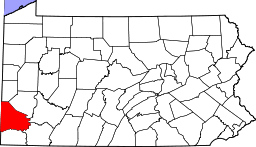Burgettstown, Pennsylvania
| Burgettstown | |
|---|---|
| Borough | |
.jpg) | |
 Location of Burgettstown in Washington County | |
 Burgettstown Location of Burgettstown in Pennsylvania | |
| Coordinates: 40°22′51″N 80°23′28″W / 40.38083°N 80.39111°WCoordinates: 40°22′51″N 80°23′28″W / 40.38083°N 80.39111°W | |
| Country | United States |
| State | Pennsylvania |
| County | Washington |
| Established | 1795 |
| Government | |
| • Mayor | Settimio Carnali |
| Area | |
| • Total | 0.6 sq mi (2 km2) |
| Population (2000) | |
| • Total | 1,576 |
| • Density | 2,600/sq mi (1,000/km2) |
| Time zone | EST (UTC-4) |
| • Summer (DST) | EDT (UTC-5) |
| Area code(s) | 724 |
Burgettstown is a borough in Washington County, Pennsylvania, United States. It is a suburb of Pittsburgh, Pennsylvania. The population was 1,576 according to the 2000 census.
History
Burgettstown was laid out in 1795 by Sebastian Burgett, and named for him.[1]
Geography
Burgettstown is located at 40°22′51″N 80°23′28″W / 40.38083°N 80.39111°W (40.380844, -80.391047).[2]
According to the United States Census Bureau, the borough has a total area of 0.6 square miles (1.6 km2), all of it land.
Surrounding communities
Joffre, Bulger, Cherry Valley, Atlasburg, Slovan, Langeloth, Eldersville, Cross Creek, Florence, Hanover Township, Paris, Studa.
Demographics
| Historical population | |||
|---|---|---|---|
| Census | Pop. | %± | |
| 1880 | 876 | — | |
| 1890 | 929 | 6.1% | |
| 1900 | 961 | 3.4% | |
| 1910 | 1,268 | 31.9% | |
| 1920 | 1,990 | 56.9% | |
| 1930 | 2,266 | 13.9% | |
| 1940 | 2,497 | 10.2% | |
| 1950 | 2,379 | −4.7% | |
| 1960 | 2,383 | 0.2% | |
| 1970 | 2,118 | −11.1% | |
| 1980 | 1,867 | −11.9% | |
| 1990 | 1,634 | −12.5% | |
| 2000 | 1,576 | −3.5% | |
| 2010 | 1,388 | −11.9% | |
| Est. 2015 | 1,352 | [3] | −2.6% |
| Sources:[4][5][6] | |||
As of the census[5] of 2000, there were 1,576 people, 656 households, and 429 families residing in the borough. The population density was 2,531.8 people per square mile (981.4/km²). There were 703 housing units at an average density of 1,129.3 per square mile (437.8/km²). The racial makeup of the borough was 96.26% White, 1.46% African American, 0.06% Native American, 0.06% Asian, 0.51% from other races, and 1.65% from two or more races. Hispanic or Latino of any race were 2.47% of the population.
There were 656 households out of which 25.5% had children under the age of 18 living with them, 45.6% were married couples living together, 14.3% had a female householder with no husband present, and 34.6% were non-families. 31.3% of all households were made up of individuals and 17.8% had someone living alone who was 65 years of age or older. The average household size was 2.34 people and the average family size was 2.93.
In the borough the population was spread out with 21.6% under the age of 18, 5.2% from 18 to 24, 28.0% from 25 to 44, 23.0% from 45 to 64, and 22.2% who were 65 years of age or older. The median age was 42 years. For every 100 females there were 86.5 males. For every 100 females age 18 and over, there were 79.4 males.
The median income for a household in the borough was $33,350, and the median income for a family was $39,271. Males had a median income of $32,885 versus $23,375 for females. The per capita income for the borough was $16,097. About 7.6% of families and 10.3% of the population were below the poverty line, including 12.8% of those under age 18 and 6.9% of those age 65 or over.
Points of interest
- First Niagara Pavilion in adjacent Hanover Township, a 23,000 seat outdoor amphitheater that hosts concerts throughout the summer
- Burgettstown Area Middle/High School, local public school that recently completed renovations for new classrooms, gymnasium and auditorium
- Burgettstown Community Library, 2 Kerr Street, home of the Ft. Vance Historical Society and the Washington-Greene County chapter of the Pennsylvania Sports Hall of Fame.
Notable people
Joe Tepsic, a Penn State halfback, who later signed a pro-baseball contract, was born in Burgettstown.
Robert Linn, known for his record setting 58 years of service as a mayor, was born in Burgettstown.
Former University of Wisconsin Head Football Coach (and current Director of Athletics) Barry Alvarez grew up in adjacent Langeloth, Pennsylvania and attended Burgettstown Jr/Sr High School (formally known as Union High School).
Robert Tucci, an orchestral musician, graduated from Union High School in 1958, was a member of the Louisville Orchestra, the Vienna Symphony Orchestra, the orchestra of the Vienna State Opera (Vienna Philharmonic), the United States Army Field Band, the Buffalo Philharmonic and the Orchestra of the Bavarian State Opera in Munich.
References
| Wikimedia Commons has media related to Burgettstown, Pennsylvania. |
- ↑ The Pennsylvania Magazine of History and Biography. Publication Fund of the Historical Society of Pennsylvania. 1886. p. 135.
- ↑ "US Gazetteer files: 2010, 2000, and 1990". United States Census Bureau. 2011-02-12. Retrieved 2011-04-23.
- ↑ "Annual Estimates of the Resident Population for Incorporated Places: April 1, 2010 to July 1, 2015". Retrieved July 2, 2016.
- ↑ "Census of Population and Housing". U.S. Census Bureau. Archived from the original on 11 May 2015. Retrieved 11 December 2013.
- 1 2 "American FactFinder". United States Census Bureau. Archived from the original on 2013-09-11. Retrieved 2008-01-31.
- ↑ "Incorporated Places and Minor Civil Divisions Datasets: Subcounty Resident Population Estimates: April 1, 2010 to July 1, 2012". Population Estimates. U.S. Census Bureau. Archived from the original on 17 June 2013. Retrieved 11 December 2013.
